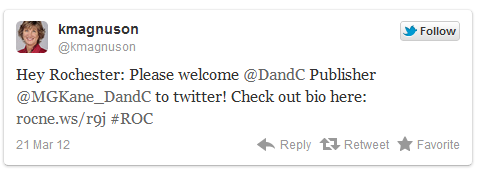
Consider this my official welcome of D&C Publisher Mike Kane to Twitter. File it under “never too late”, which is apparently the D&C management’s attitude about the Internet in general.
Mike, when you kill your newspaper by instituting a paywall, perhaps that will give you time to reflect on why nobody wants to advertise in the D&C in the first place. Let’s start with the basics. Do you realize the utter commercial failure embodied in splitting up stories so I have to page 3 times to read a few hundred words, while burying your ads at the bottom of the page? Here’s an example from today’s D&C. There are 12 ad positions and four sponsored links below the place where I click “next page” to see the next page of the story. In other words, most of the ads are in places I’ll never look, by design. You make readers click three times to expose them to ads they’ll never see. Do you think they’ll be lining up to pay to click 3 times to read that story?
As has been the case for the last decade, most of those ads they’re not seeing are the usual Internet junk, at best fake-localized:
 That’s not an ad about Fairport, its an ad that figured out that my Internet connection is near Fairport (I’m actually in Pittsford, but good try) to try to sell me some scam. Why would any Rochester advertiser want to put their brand next to this kind of crap?
That’s not an ad about Fairport, its an ad that figured out that my Internet connection is near Fairport (I’m actually in Pittsford, but good try) to try to sell me some scam. Why would any Rochester advertiser want to put their brand next to this kind of crap?
Speaking of our home town, let’s look at the Pittsford page of the D&C. There are five ads on this page. Two of them are from MacDonald’s. One’s from a city charter school, one’s a sponsorship link from Cars.com, and one’s a house ad for Careerbuilder. There’s a new bakery in downtown Pittsford, and there are lots of new businesses opening and closing in Pittsford Plaza, yet not a single one of these businesses has chosen to advertise on your local landing page or on the Pittsford blog. They’re spreading the word via social media, they’re posting their new business on RocWiki, Yelp and Google, and they’re advertising in the Brighton-Pittsford Post and the Penny Saver. What they’re not doing is spending any money with you.
Howard Owens, who publishes The Batavian and sells a lot of ads, is right about your paywall — it’s going to open up opportunities for your competitors. You should read his stuff carefully, because he’s making money where you aren’t. But even without a paywall, your competition is already beating you, because your company is apparently unable to do what newspapers have done to support themselves for a couple hundred years: sell ads to local advertisers.
So, Mike, welcome to Twitter, and good luck with your paywall. One piece of advice: fasten your seatbelt, it’s going to be a bumpy ride.
Update: Apparently Karen doesn’t like criticism.



